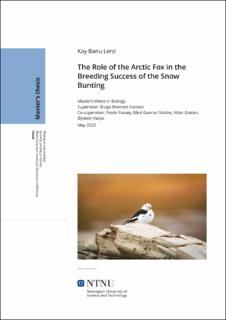| dc.description.abstract | The reproductive success of breeding birds can be determined by many different factors. One
factor often associated with the failure of a brood is nest depredation. To avoid depredation,
different bird species implement different adaptations. Some species have evolved a specific
nesting-strategy, for example cavity-nesting. In addition to the top-down regulation by
predators, breeding birds are also subjected to changing climatic conditions. Bird species which
are breeding in the high Arctic, where the breeding season is short and the effects of Arctic
warming have already led to changes in the local climate, can be very sensitive to those factors.
In this thesis, I explore the role of the Arctic fox (Vulpes lagopus) and its top-down effect on
the fledging success of a population of migratory snow buntings (Plectrophenax nivalis) on
Svalbard. First, I investigated how the nest’s accessibility influences the daily probability of
snow bunting broods being depredated by the Arctic fox and how the predation pressure
changes on snow bunting nests throughout the season. Then, I investigated the role of fox
abundance in the reproduction of the snow bunting in comparison to weather factors, which
have previously been found to impact the breeding success significantly. I used a 22-year long
time series from 1998 to 2020 of monitored snow bunting nests in Adventdalen. My analysis
revealed nest height to be the dominating factor influencing the daily probability of a nest being
depredated. In addition, I found a tendency of broods that were started later in the season to be
more depredated than earlier broods. Arctic fox abundance had a rather small effect on the snow
buntings’ fledging success in comparison to the local climate. The mean temperature had a
strong impact on the fledging success, as well as the timing of breeding. This study shows the
Arctic fox might not play an essential role in the snow bunting population’s breeding success
at present. However, there are implications that future warming will impact both the snow
bunting and the Arctic fox and might therefore also alter their interactions with each other. | |
